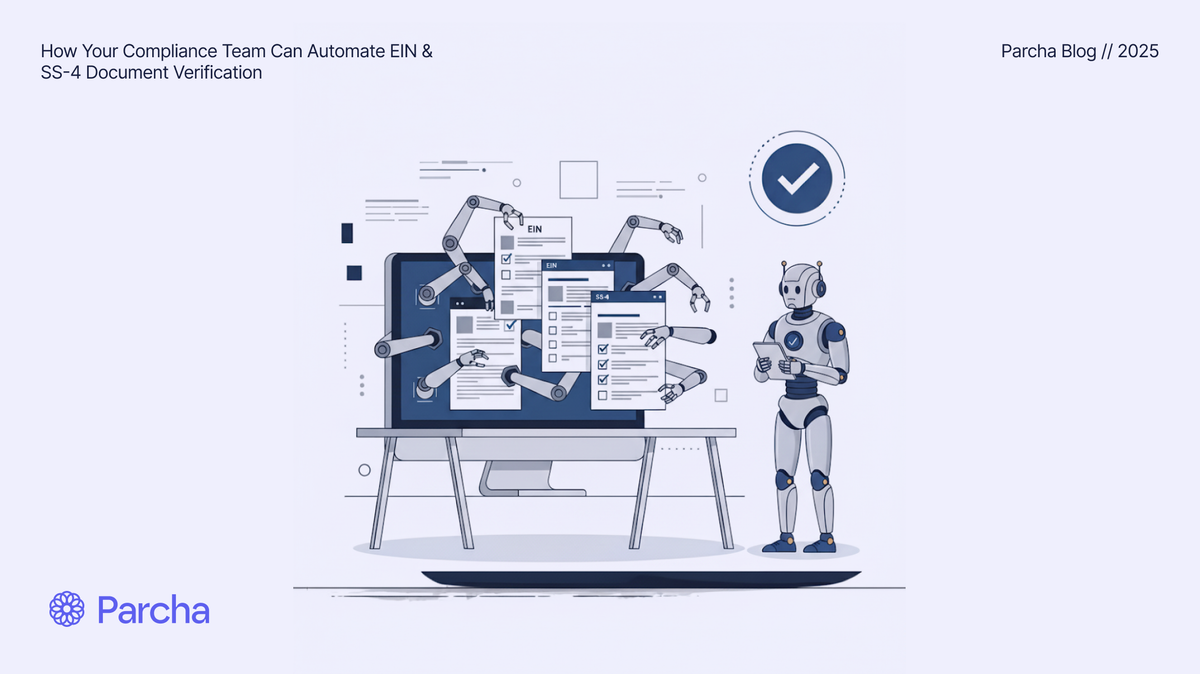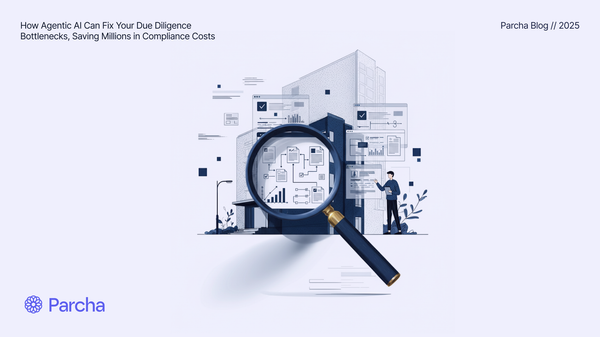How Your Compliance Team Can Automate EIN & SS-4 Document Verification

When onboarding U.S. counterparties, subsidiaries, or corporate clients, you can’t afford to treat EIN (Employer Identification Number) validation as just another box to tick.
It’s one of the primary anchors for KYB and AML controls.
Yet, too often, you’re left exposed by:
- Fake or fabricated EINs
- Mismatched SS-4 forms
- Sluggish, error-prone manual checks
A missed red flag can snowball into delayed audits, regulator scrutiny, or worse.
Tired of firefighting errors and chasing down documents? It may be time to rethink how your team handles EIN verification.
Why Relying on a Simple EIN Lookup Isn’t Enough
A quick EIN lookup may feel like due diligence, but it’s rarely sufficient. IRS TIN match services and public databases don’t cover everything. You’ll often find gaps with newly formed or privately held entities.
Let’s say a fintech client hands you an SS-4 form with their new EIN, but the lookup tool shows nothing.
Most likely, that’s not fraud. It’s just that the EIN hasn’t yet populated in third-party databases.
Additionally, mismatches in company name or address can trigger false red flags. Without supporting documents, you’re left in limbo: unable to confirm whether you’re facing real risk or a simple data lag.
The Role of IRS Documents (SS-4, CP 575, 147C, Tax Returns)
This is where IRS-issued documents come in:
- SS-4 – the original application showing what the company submitted.
- CP 575 – the confirmation letter proving the EIN was assigned.
- 147C – an IRS verification letter that reconfirms the EIN.
- Prior tax returns – evidence the EIN has been actively used.
These documents help you untangle mismatches in names, addresses, or dates that a lookup can’t explain. Without them, you risk flagging good clients as suspicious. Or worse, letting bad actors slip through.
How an “EIN Document Verification Agent” Can Help
Instead of burning hours manually reviewing SS-4s and IRS letters, you can hand the work off to an EIN document verification agent. Think of it as an AI-powered compliance analyst. It ingests IRS documents (SS-4, CP 575, 147C, tax returns), parses the data, and cross-checks against trusted sources.
In practice, it works like this: you upload an SS-4 and CP 575. The agent validates the EIN, compares the entity name, address, and issue date. If something doesn’t line up – say, the CP 575 shows a different “doing business as” name – it flags the mismatch immediately.
For you as a compliance leader, the benefits are clear:
- Cut manual review time without cutting corners.
- Catch fraud earlier by spotting inconsistencies across documents.
- Stay audit-ready with automated logs showing exactly how verification was performed.
And importantly, these AI agents don’t make black-box decisions. If a discrepancy arises, they escalate to your team with a transparent decision path, so you’re always in control of the final call.
Data Sources to Cross-Check
To get this right, the agent draws from multiple sources:
- IRS EIN/TIN match services
- Secretary of State or other state-level business registries
- Credit bureaus and business data providers
- Historical tax return databases
One caveat: Newly issued EINs may not show up immediately everywhere, so the system accounts for timing gaps. That way, you don’t mistake a new business for a fraudulent one.
Selecting an EIN Verification Solution
When choosing an EIN verification solution, you need to look for something more than basic automation. You need agentic AI that acts like a compliance analyst, not just a data scraper. Focus on these key areas:
- Document ingestion & OCR accuracy – Ensure the system can handle scanned SS-4s, CP 575s, and other IRS documents without misreading critical fields. For example, smudged or rotated PDFs shouldn’t create false mismatches.
- Data normalization & alias handling – Names like “ABC LLC” vs “ABC, LLC” or abbreviations must be standardized so minor formatting differences don’t trigger unnecessary flags.
- Flagging & escalation logic – Your agent should classify results as exact match, probable match, or mismatch, and escalate ambiguous cases to your team automatically.
- Audit trail & versioning – Every verification step must be logged so you can demonstrate to auditors or regulators exactly how each decision was made.
- Fallback manual review workflows – No AI is perfect; allow human override to resolve edge cases.
- Latency & throughput – Make sure the solution can process batches quickly, without slowing down onboarding.
- Security, privacy, and regulatory compliance – IRS documents contain sensitive data; your system must encrypt, log, and comply with all applicable regulations.
For instance, an agent receives a batch of SS-4 forms. It extracts EINs, compares names and addresses against IRS and state records, flags three probable mismatches, and automatically escalates them to your compliance team. Meanwhile, audit-ready logs record exactly how each match or mismatch was determined.
By following these best practices, you ensure the agent isn’t just automating work. It’s strengthening your KYB and AML program, while ensuring you stay fully in control.
Use Cases: Putting It to Work
A reliable EIN verification agent can be useful across multiple compliance workflows:
- Onboarding U.S.-registered corporate clients – Quickly validate EINs for fintech clients to ensure KYB and AML compliance before accounts go live.
- Vendor or supplier checks – If a supplier claims a U.S. presence, verify their EIN and documents to prevent onboarding fraud.
- M&A diligence – Confirm the target company’s EIN, tax filings, and historical compliance to avoid surprises post-acquisition.
- Renewal & periodic revalidation – EINs and corporate details can change; automated periodic checks catch discrepancies or fraud early.
When onboarding a U.S.-registered corporate client or customer, let’s say an SS-4 shows EIN “12-3456789” for “Acme Corp.” The AI agent cross-checks state registries and finds “Acme Corporation” with the same EIN but a different address. It flags a “possible alias” mismatch.
Your team can then request a CP 147C from the client, quickly resolving the discrepancy and maintaining a clean audit trail.
By applying the AI agent across these scenarios, you reduce manual workload, catch inconsistencies early, and ensure every verification is traceable and regulator-ready.
Strengthen Your Compliance with Automated EIN Verification
Robust EIN document verification must be a cornerstone of any U.S. KYB and AML program. Skip it, and you risk onboarding invalid or fraudulent entities, leaving gaps in your audit trail, and exposing your organization to regulatory scrutiny.
As a compliance leader, it’s time to rethink how your team handles EINs. Evaluate or pilot an EIN document verification agent, like Parcha’s AI-powered solution, to streamline reviews, catch inconsistencies early, and maintain audit-ready logs.
Explore Parcha’s knowledge base or reach out directly to see how quickly your team can implement automated, reliable EIN verification.





